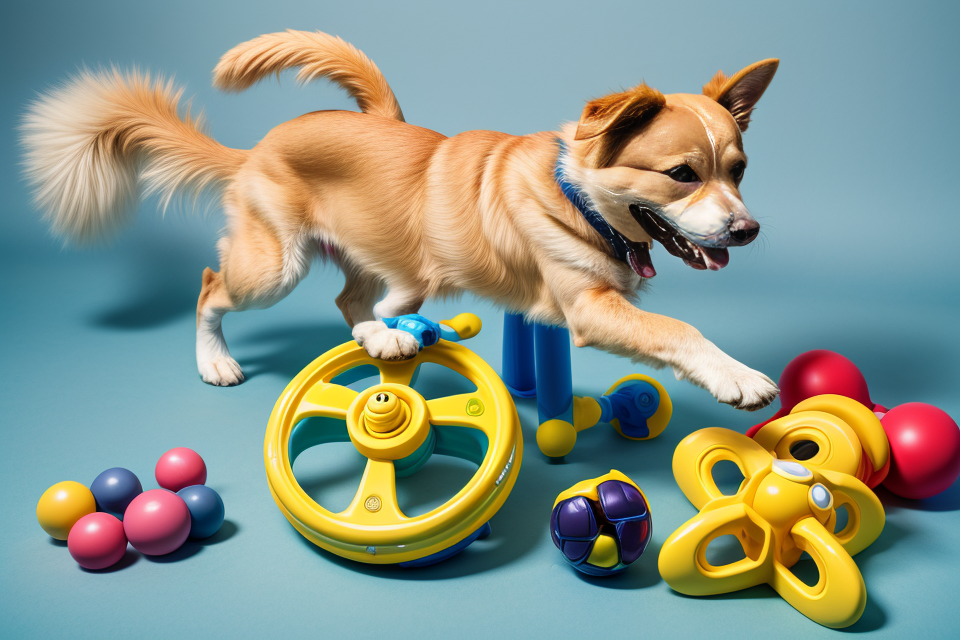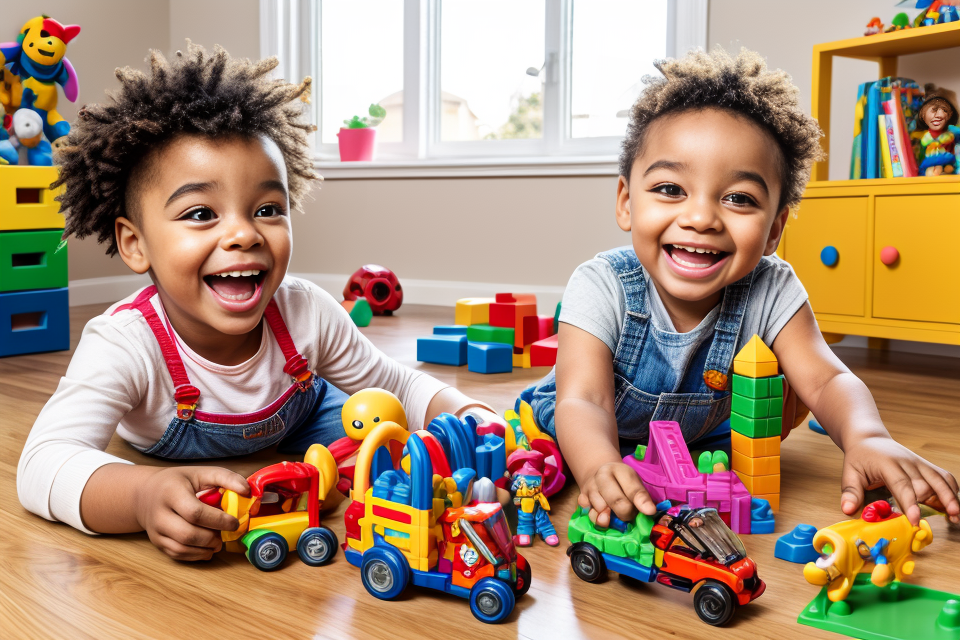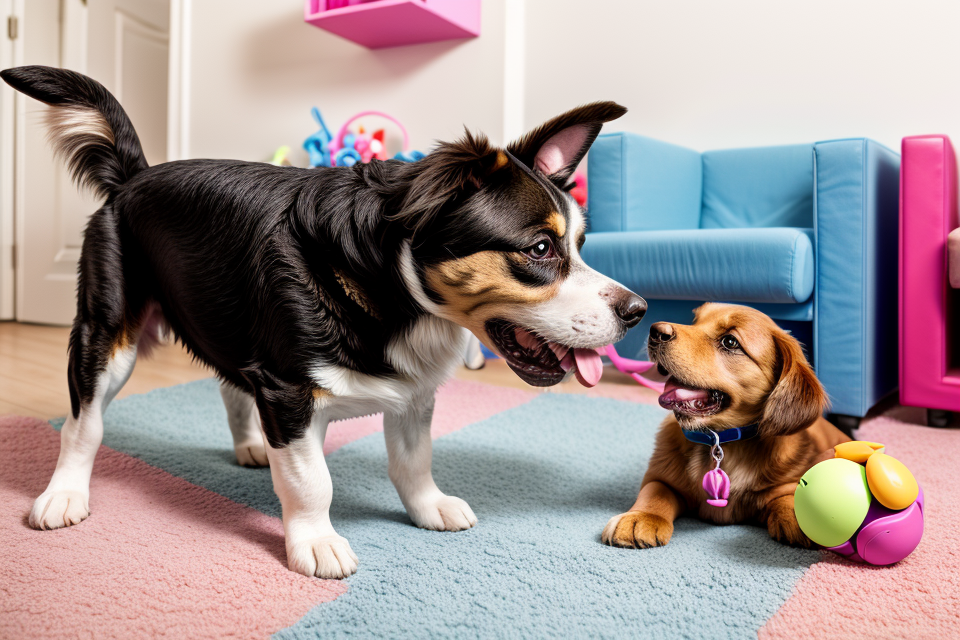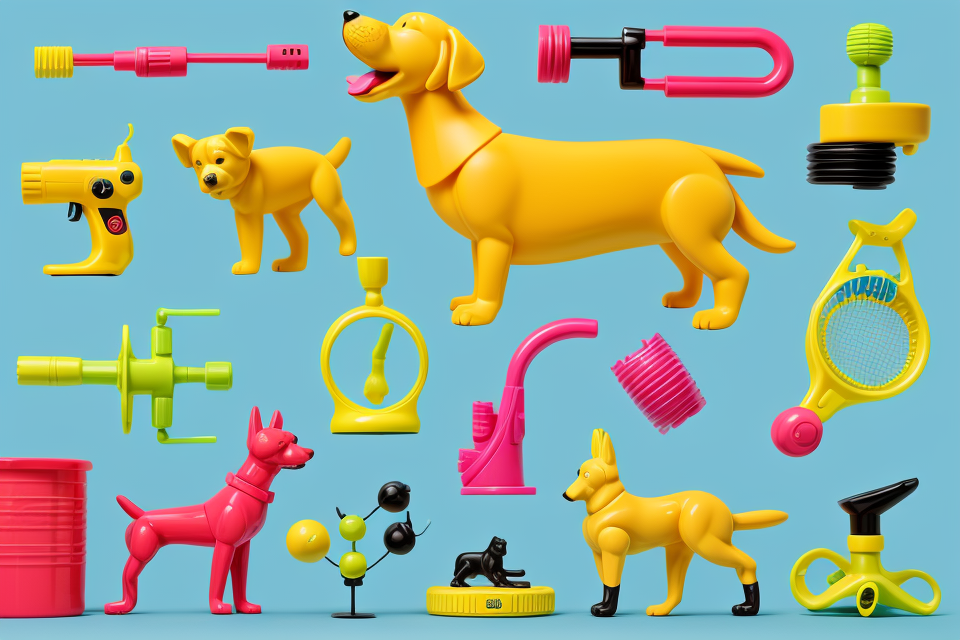As a dog owner, it’s important to keep your furry friend active and engaged, especially when they’re stuck at home. But with so many training toys on the market, it can be hard to know which ones are worth your time and money. That’s why we’ve put together a guide to the best training toys for keeping your dog active and entertained at home. From interactive puzzles to tug-of-war ropes, we’ll cover a range of toys that are sure to keep your pup engaged and excited. So whether you’re looking for a new way to challenge your dog or just want to keep them occupied while you’re busy, we’ve got you covered.
What are the Best Training Toys for Dogs?
Benefits of Training Toys for Dogs
- Physical and mental stimulation: Training toys provide dogs with the necessary physical and mental stimulation they need to stay healthy and happy. These toys help prevent boredom and keep dogs engaged, which in turn reduces the likelihood of destructive behavior.
- Bonding with the owner: Playing with training toys is an excellent way for dogs to bond with their owners. Interactive toys such as puzzle toys and treat dispensing toys allow dogs and owners to play together, strengthening their relationship.
- Preventing boredom and destructive behavior: Boredom can lead to destructive behavior in dogs, such as chewing on furniture or other items in the home. By providing dogs with training toys that challenge their minds and keep them engaged, owners can prevent boredom and reduce the likelihood of destructive behavior.
Types of Training Toys for Dogs
Interactive toys are a great way to keep your dog engaged and entertained. These toys are designed to stimulate your dog’s natural instincts and provide mental and physical stimulation. Examples of interactive toys include fetch toys, tug toys, and treat dispensing toys.
Durable toys are made to withstand the wear and tear of playtime. These toys are designed to last and can be used for a long time. Examples of durable toys include ropes, balls, and chew toys.
Puzzle toys are designed to challenge your dog’s problem-solving skills. These toys typically have hidden treats or compartments that your dog must figure out how to access. Examples of puzzle toys include hide-and-seek toys and treat-dispensing puzzles.
Scent work toys are designed to stimulate your dog’s sense of smell. These toys typically have hidden treats or scents that your dog must sniff out. Examples of scent work toys include scent-work puzzles and training aids.
Top Picks for Training Toys for Dogs
When it comes to keeping your dog active and engaged, the right training toys can make all the difference. Here are some top picks for training toys that will keep your furry friend entertained and learning:
- Interactive Puzzle Toys: These toys challenge your dog to solve problems and think critically, which can help improve their cognitive abilities. Examples include the Kong and Nina Ottosson toys.
- Tug Toys: Tug toys are great for strengthening your dog’s jaw and teaching them to drop a toy on command. Examples include the Ruffwear and Planet Dog brands.
- Snuffle Mats: These mats are filled with dog-safe, unscented items for your dog to sniff out. They are great for improving your dog’s nose work skills and can be used for training and play. Examples include the Pet Safe and Knucklebones brands.
- Flat Reward Toys: These toys are perfect for training sessions and can be filled with treats or peanut butter for extra incentive. Examples include the Nylabone and Dingo brands.
- Frisbee and Flyer Discs: These toys are great for teaching your dog to catch and retrieve, as well as for aerobic exercise. Examples include the Disc Dog Express and Pet Fly brands.
When choosing training toys for your dog, consider their size, strength, and individual preferences. The right toys can help keep your dog active, engaged, and learning new skills.
Tips for Choosing the Right Training Toys for Your Dog
Consider Your Dog’s Size and Breed
When it comes to choosing the right training toys for your dog, one of the most important factors to consider is their size and breed. Here are some things to keep in mind:
Large Dogs vs Small Dogs
If you have a large dog, you’ll want to make sure you get toys that are durable and can withstand their powerful jaws. Some good options for large dogs include rubber balls, ropes, and toys made from tough materials like nylon or leather. For small dogs, you’ll want toys that are soft and won’t hurt them if they accidentally bit down on them. Some good options for small dogs include stuffed animals, soft balls, and toys made from soft materials like plush.
Breed-Specific Needs
Different breeds have different needs when it comes to training toys. For example, if you have a retriever, they’ll love toys that allow them to use their natural instincts to fetch. If you have a terrier, they’ll enjoy toys that allow them to use their digging and hunting instincts. It’s important to do some research on your breed’s specific needs and choose toys that will be the most engaging and enjoyable for them.
In addition to size and breed, you should also consider your dog’s individual personality and preferences when choosing training toys. Some dogs may prefer interactive toys that they can play with you, while others may prefer toys that they can play with on their own. It’s important to take all of these factors into account when choosing the best training toys for your dog.
Look for Quality and Durability
When it comes to choosing the right training toys for your dog, it’s important to consider the quality and durability of the toys. Here are some factors to keep in mind:
- Materials used: The materials used to make the toys can affect their durability and safety. Look for toys made from high-quality, non-toxic materials that are safe for your dog to chew on.
- Durability: You want toys that can withstand the rough play of your dog. Look for toys that are made to last, with sturdy construction and reinforced seams.
- Safety: Safety should always be a top priority when choosing toys for your dog. Look for toys that are designed with safety in mind, such as toys that are free of small parts that can be swallowed or choked on. Additionally, make sure the toys are appropriate for your dog’s size and strength, as larger dogs may be able to easily destroy toys that are not sturdy enough.
By considering these factors, you can choose training toys that will provide your dog with hours of fun and engagement, while also ensuring their safety and satisfaction.
Encourage Positive Play Behavior
Reward good behavior
One of the most effective ways to encourage positive play behavior in your dog is to reward them for good behavior. When your dog engages in appropriate play with their toys, be sure to praise them and give them plenty of affection. This positive reinforcement will encourage your dog to continue engaging in good behavior and will help them understand what is expected of them.
Gradual introduction
When introducing new toys to your dog, it’s important to do so gradually. Start by giving them a small number of toys at a time and gradually increase the number as they become more comfortable with the toys. This will help prevent overwhelming your dog and will give them time to learn how to properly engage with the toys.
Supervision
It’s important to supervise your dog when they are playing with their toys. This will help ensure that they are engaging in appropriate play behavior and will allow you to intervene if necessary. Supervision will also help prevent your dog from becoming bored with their toys or becoming destructive with them.
By following these tips, you can encourage positive play behavior in your dog and keep them active and engaged with the best training toys.
Creating a Training Plan for Your Dog
Setting Goals
When creating a training plan for your dog, it’s important to set specific goals that are achievable and realistic. Here are some examples of goals you may want to consider:
- Improve obedience: This could include teaching your dog basic commands such as “sit,” “stay,” “come,” and “heel.” You may also want to work on more advanced obedience training, such as teaching your dog to wait before jumping up on people or to walk nicely on a leash.
- Increase physical activity: Dogs need regular exercise to stay healthy and happy. Depending on your dog’s breed and size, you may want to aim for a certain amount of exercise per day or week. This could include going for walks, playing fetch, or engaging in other activities that get your dog moving.
- Reduce anxiety: Some dogs may become anxious or stressed in certain situations, such as during thunderstorms or when left alone. By working with a professional trainer or behaviorist, you can develop a plan to help your dog cope with these situations and reduce their overall anxiety levels.
It’s important to remember that every dog is different, and what works for one dog may not work for another. When setting goals for your dog, it’s important to take into account their individual needs and abilities. By creating a training plan that is tailored to your dog’s specific needs, you can help them become a well-behaved, happy, and healthy companion.
Training Schedule
Frequency
When it comes to training your dog, frequency is key. It is recommended to train your dog at least once a day, but more is better. Daily training sessions help to reinforce good behavior and prevent bad habits from forming. Additionally, training your dog regularly helps to strengthen the bond between you and your dog.
Duration
The duration of each training session will depend on your dog’s age, breed, and temperament. For puppies, training sessions should be shorter and more frequent, while older dogs may require longer sessions. It is important to keep training sessions fun and engaging for your dog, so don’t overdo it and risk causing boredom or frustration.
Consistency
Consistency is crucial when it comes to training your dog. This means sticking to a regular training schedule and using the same commands and techniques throughout. Consistency helps your dog to understand what is expected of them and helps to prevent confusion and confusion. It is also important to be consistent with your dog’s diet, exercise, and other routines to help them feel secure and comfortable in their environment.
Reinforcement and Positive Reinforcement
Rewards
One of the most effective ways to reinforce positive behavior in your dog is through the use of rewards. This can include treats, toys, or even verbal praise. When your dog exhibits the desired behavior, immediately provide them with the reward to reinforce the behavior and let them know that they have done well. It’s important to make sure that the reward is something that your dog values and is motivated by, as this will help to keep them engaged and interested in the training process.
Praise
In addition to providing rewards, it’s also important to give your dog plenty of praise and positive reinforcement. This can include verbal praise, such as saying “good boy” or “well done,” or physical touch, such as giving them a pat on the head or a rub behind the ears. When you give your dog praise, be sure to do so in a sincere and enthusiastic manner, as this will help to reinforce the behavior and let your dog know that they are doing well.
Playtime
Another effective way to reinforce positive behavior in your dog is through playtime. When your dog exhibits the desired behavior, engage in a play session with them as a reward. This can include playing fetch, tug-of-war, or any other activity that your dog enjoys. Playtime is a great way to keep your dog active and engaged, and it can also help to strengthen the bond between you and your dog.
Overall, reinforcement and positive reinforcement are key components of a successful training plan for your dog. By using rewards, praise, and playtime, you can help to keep your dog active and engaged, and encourage them to exhibit positive behavior.
Enjoy Your Active and Engaged Dog!
Bonding Activities
Outdoor Walks
One of the best ways to keep your dog active and engaged is by taking them on regular outdoor walks. Not only does this provide them with the physical exercise they need, but it also gives them the opportunity to sniff and explore their surroundings. Make sure to vary your walking route to keep things interesting for your dog, and consider bringing along some training treats to reinforce good behavior during the walk.
Playtime with Owner
Playing with your dog is not only a fun way to bond with them, but it also helps to keep them mentally stimulated and physically active. You can engage your dog in a variety of games, such as fetch, tug-of-war, and hide-and-seek. Be sure to vary the types of games you play to keep things interesting for your dog, and always supervise playtime to ensure your dog’s safety.
Snuggling on the Couch
While it may seem like a lazy option, snuggling on the couch with your dog can actually be a great way to bond with them and provide them with the emotional support they need. Dogs are social animals and enjoy being close to their owners, so taking some time to cuddle up on the couch can be a great way to strengthen your bond. Just be sure to set aside dedicated time for couch potato sessions and avoid spending all your time sitting on the couch.
Monitoring Your Dog’s Health and Well-being
Regular vet check-ups
As a responsible dog owner, it is crucial to schedule regular vet check-ups for your furry friend. These check-ups are essential for maintaining your dog’s overall health and well-being. During these visits, your veterinarian will perform a thorough physical examination, update your dog’s vaccinations, and discuss any concerns or issues you may have about your dog’s health. It is also an excellent opportunity to ask any questions you may have about your dog’s diet, exercise, and general care.
Maintaining a healthy diet
In addition to regular vet check-ups, it is essential to provide your dog with a healthy and balanced diet. This means feeding your dog high-quality dog food that is rich in essential nutrients and avoiding giving them human food, as this can be harmful to their health. It is also important to monitor your dog’s food intake and avoid overfeeding, as this can lead to obesity and other health problems.
Providing appropriate exercise
Exercise is essential for keeping your dog active and engaged. It helps to prevent boredom, reduce anxiety, and maintain a healthy weight. Depending on your dog’s age, breed, and size, you should provide them with appropriate levels of exercise. For example, smaller dogs may require shorter, more frequent walks, while larger dogs may need longer, more intense walks. It is also essential to provide your dog with mental stimulation, such as interactive games and puzzles, to keep their mind active and engaged.
FAQs
1. What are the best training toys for keeping dogs active at home?
There are many different types of training toys that can help keep dogs active and engaged while at home. Some popular options include puzzle toys that challenge dogs to figure out how to get treats out, interactive toys like fetch toys and tug ropes, and sensory toys that provide different textures and sounds for dogs to explore.
2. How often should I give my dog new toys to keep them engaged?
It’s a good idea to give your dog new toys on a regular basis to keep them interested and engaged. Depending on how often your dog plays with their toys, you may want to replace them every few months or so. You can also rotate their toys to keep them interested and prevent boredom.
3. Can I use regular toys for training, or do I need specialized training toys?
While regular toys can be used for training, specialized training toys can be more effective at keeping dogs engaged and motivated. These toys are often designed to challenge dogs mentally and physically, and can help improve their problem-solving skills and physical fitness.
4. How much exercise does my dog need to stay active and healthy?
The amount of exercise your dog needs depends on their age, size, and breed. As a general rule, dogs should get at least 30 minutes of exercise per day, but some breeds may require more. It’s important to talk to your veterinarian to determine the appropriate amount of exercise for your dog.
5. Can I use food-based rewards for training my dog?
Yes, you can use food-based rewards for training your dog. However, it’s important to make sure that you’re using high-value treats that will motivate your dog to participate in training. You should also be mindful of your dog’s diet and make sure that they’re not getting too many treats, as this can lead to weight gain.



